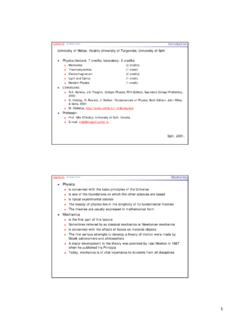Transcription of Lecture Notes for College Physics I - Academics
1 Lecture Notes for College Physics IContents1 Vector Algebra12 Kinematics of Two-Dimensional Motion23 Projectile Motion54 Newton s Laws of Motion85 Force Problems126 Forces due to Friction and Uniform Circular Motion167 Newton s Law of Universal Gravitation208 Work-Energy Theorem I229 Work-Energy Theorem II2410 Linear Momentum and Collisions3011 Rotation Kinematics & Dynamics3612 Problems in Rotational Dynamics4013 Statics4514 Oscillations4715 Waves5211 Vector AlgebraTextbook Reference: Chapter 3 sections 1-6 & Appendix A. Definition of a Vector A vectorvis determined in terms of its magnitudev=|v|and its direction v=v/v.
2 In two-dimensional space, a vectorvis written asv=vx x+vy y,where x=(1,0) and y=(0,1) are unit vectors in the directions of increase ofxandy,respectively, and (vx,vy) denotes its components. In terms of its components (vx,vy), the magnitude of the vectorvisv=|v|= v2x+v2y,while its direction is v=vx v2x+v2y x+vy v2x+v2y : The magnitude of a vector is alwayspositive. The direction unit vector vcan also be represented in terms of the direction angle as v= cos x+ sin y. Vector Algebra1 Multiplication of a Vectorvby a Scalar v=( vx) x+( vy) y | v|= ( vx)2+( vy)2=| ||v| v=( /| |) v Vector additionw=u+vw=wx x+wy y=(ux+vx) x+(uy+vy) yExample:u=u xandv=v(cos x+ sin y)w= u2+v2+2uvcos and tan =vsin u+vcos Note: Direction angle is defined as follows = arctan(wy/wx)ifwx>0 + arctan(wy/wx)ifwx<0 Test your knowledge: Problems 4-7 & 12 of Chapter 32 Kinematics of Two-Dimensional MotionTextbook Reference: Chapter 3 section 6.
3 Vector Kinematics2 Kinematics is the part of Physics that contains the terminology used to describe themotion of particles. For this purpose, the first element of the kinematic description ofthe motion of a particle involves tracking its position as a function of time. Because themotion of the particle may involve more than one spatial dimension, a vector representationis adopted. Hence, the position of a particle at timetis denoted asr(t) or, assuming thatthe motion takes place in two dimensions, asr(t)=x(t) x+y(t) y=(x(t),y(t)).Since the initial position of the particle is often known, we denote the initial position ofthe particle asr0=x0 x+y0 y=(x0,y0).
4 Questions that immediately arise are (a) thedistance covered and (b) the net displacement experienced by the particle in going from theinitial positionr0to the instantaneous positionr(t). It turns out that we cannot answerthe first question without known the path taken by the particle between these two points( , the particle may zigzag its way between the two points making the distance coveredfar greater than the distance separating the two points). If the path taken is a straightline, however, then the distance covered by the particle is simply given by the distance|r(t) r0|between the two points|r(t) r0|= (x(t) x0)2+(y(t) y0) answer to the second question introduces the definition of the net displacement vector r(t)=r(t) r0=[x(t) x0] x+[y(t) y0] that the net displacement experienced by a particle is zero if the particle returns toits initial point, while the distance covered by the particle along this closed path is that we know how to describe the positionr(t)
5 Of a particle and find its displace-ment r(t) from an initial positionr0, we are interested in describing how fast the particleis moving. Here, we need to introduce the concepts ofinstantaneousvelocityv(t) and3averagedvelocityv(t). The averaged velocity is simply calculated by determining thenet dispacement r(t) experienced by a particle during a given time interval t=tandcalculating the ratio:v(t)= r(t) t= x(t) t x+ y(t) t instantaneous velocityv(t), however, can only be defined mathematically ( , we knowit exists physically but cannot measure it experimentally!)
6 The instantaneous velocityv(t)can be calculated from the averaged velocityv(t) by letting the interval tgo tozero:v(t) = lim t 0 r(t+ t) t=dr(t)dt=dx(t)dt x+dy(t)dt y,which naturally introduces the concept of a timederivative. Note from the Figure shownabove that the instantaneous velocityv(t)isalways tangentto the curver(t) representingthe path of the particle while the averaged velocityv(t) is always in the same direction asthe net displacement r(t).Whereas the concept of velocity is associated with displacement, the concept ofspeedis associated with the distance covered by the particle.
7 In fact, aspeedometermeasuresonly speed while the determination of velocity requires the direction of motion ( , givenby a compass) as well as its last kinematic attribute of particle motion involves the determination of whetherthe instantaneous velocityv(t) of the particle changes as a function of time. We definethe instantaneous acceleration vectora(t) to be the rate of change of the instantaneousvelocityv(t):a(t) = lim t 0 v(t+ t) t=dv(t)dt=dvx(t)dt x+dvy(t)dt y,while the averaged acceleration is simply defined asa= v/ t. Note that the instanta-neous acceleration of a particle can also be defined in terms of the second time derivativeof its instantaneous positionr(t):a(t)=d2r(t)dt2=d2x(t)dt2 x+d2y(t)dt2 Motion under Constant AccelerationWhen a particle moves under constant accelerationa, its instantaneous velocityv(t)isdefined asv(t)=v0+at=(vx0+axt, vy0+ayt),wherev0denotes the particle s initial velocity, while its instantaneous positionr(t)isdefined asr(t)=r0+v0t+12at2=(x0+vx0t+12axt2,y0+v y0t+12ayt2).
8 Note that from these definitions we recoverv(t)=dr(t)/dtanda=dv(t)/dt=d2r(t) also that the averaged velocityv(t) obeys the equationv(t)=v0+12at, , the averaged velocity still evolves linearly but now athalfthe value of the , we note that the components (x, x0;vx,vx0;ax) and (y,y0;vy,vy0;ay) each in-dependently satisfy the relationv2x=v2x0+2ax(x x0) andv2y=v2y0+2ay(y y0),where the time coordinatethas been completely your knowledge: Problems 18, 21 & 23 of Chapter 33 Projectile MotionTextbook Reference: Chapter 3 sections problem of projectile motion involves the kinematic description of the path of anobject (theprojectile) moving in the presence of the constant gravitational accelerationa= g y, whereg= denotes the standard value equations of projectile motion arex(t)=v0cos ty(t)=H+v0sin t g2t2vy(t)=v0sin gt5whereHdenotes the initial height at which the projectile was launched (for convenience,we set the initial horizontal positionx0= 0),v0denotes the initial launch speed and denotes the initial launch angle (see Figure below).
9 As can be seen from the Figure above, the projectile reaches a maximum height, denotedymax, as its vertical velocityvyreaches zero (if 0< <90o) as a result of the fact that thedownward graviational acceleration slows down the upward motion until it stops. Fromthat moment onward, the vertical component of the projectile s velocity becomes negativeand continues to increase until the projectile hits the ground (aty= 0) after having covereda horizontal Maximum HeightThe projectile reaches a maximum heightymaxafter a timeTmaxdefined as the timewhen the vertical componentvy(t) vanishes.
10 Vy(Tmax)=0=v0sin gTmax Tmax=v0sin that time, we may now calculate the vertical position of the projectile asymax=y(Tmax)=H+v0sin v0sin g g2(v0sin g)2=H+(v0sin )22g,while it has traveled the horizontal distancex(Tmax)=v0cos v0sin g=v20g cos sin . Free FallThe next phase of the projectile motion after the object starts its descent involves theprojectilefallingfrom a heightymaxwith zeroinitialvertical velocityvy max= 0. Theequation of motion for this free-fall phase can be written asy(t)=ymax g2t2andvy(t)= projectile, therefore, hits the ground after a timeTf allhas elapsed (since the time ithas reached the maximum heightymax), which is defined asy(Tf all)=ymax g2T2f all Tf all= the time when the projectile hits the ground, it has traveled an additional horizontaldistancex(Tf all)=v0cos 2ymaxg.








